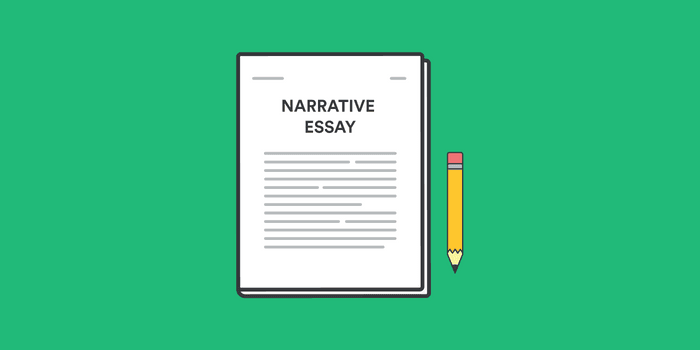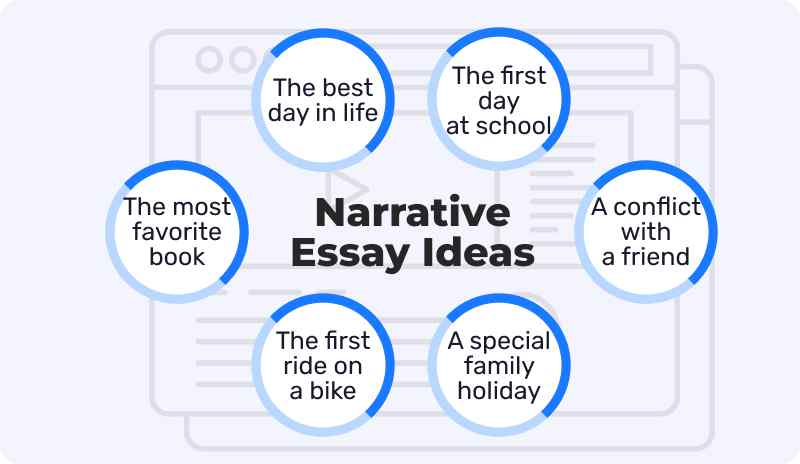Writing a Narrative Essay: Your Ideal Resource
Published 02-20-2024
17995

Writing a Narrative Essay: Your Ideal Resource
According to Purdue University writing lab, a narrative essay is a form of writing that tells a story, typically based on the personal experiences, observations, or reflections of the author. Unlike other forms of essays, such as expository or argumentative essays, narrative essays focus on storytelling rather than analysis or persuasion.
In a narrative essay, the author recounts a series of events or experiences in a chronological order, often using the first-person perspective (“I” or “we”) to create a sense of intimacy and personal connection with the reader. The narrative may involve characters, settings, conflicts, and resolutions, much like a short story, but it is rooted in real-life events or personal anecdotes.
What is the goal of a Narrative Essay?
The primary goal of a narrative essay is to engage the reader and evoke emotions, empathy, or insight through the power of storytelling. By sharing personal experiences or observations, the author invites readers to accompany them on a journey, offering glimpses into their thoughts, feelings, and reflections along the way.
Narrative essays can vary widely in tone, style, and subject matter, ranging from humorous anecdotes to poignant reflections on life's challenges and triumphs. Narrative essays invite readers to step into the shoes of the author and experience the world through their eyes, irrespective of the specific topic or theme.
Narrative essay elements and format
Narrative essays encompass various elements and adhere to a specific format to convey a story effectively. Literary Owls has compiled the key elements and format commonly found in narrative essays using credible online sources such as Lewis University’s writing center and have been listed below.
A. Introduction
The introduction sets the stage for the narrative and grabs the reader's attention. It may include a hook, such as a compelling anecdote, intriguing question, or vivid description, to draw readers in. The introduction introduces the main characters, setting, and context of the story. It typically ends with a thesis statement that previews the main idea or theme of the narrative.
B. Body paragraphs
The body paragraphs unfold the events of the story in a chronological order. Each paragraph focuses on a specific event, scene, or aspect of the narrative. It uses details, dialogue, and descriptive language to bring the story to life and engage the reader. In addition, it uses transitional phrases or sentences to smoothly transition between paragraphs and maintain the narrative flow.
C. Conclusion
This section provides closure to the narrative and reinforces its main idea or theme. The conclusion may reflect on the significance of the events described in the narrative and offer insights or lessons learned. It leaves a lasting impression on the reader and reinforces the emotional or intellectual impact of the narrative.
D. Narrative elements
Characters, setting, plot, theme and conflict make up the core elements in a narrative essay. Characters are the individuals or entities involved in the story, including the protagonist (main character) and supporting characters. The setting describes the time and place in which the events of the story occur, providing context and atmosphere. The plot highlights the sequence of events that drive the narrative forward, including the introduction of conflict, rising action, climax, falling action, and resolution. The element of conflict describes the central problem or challenge faced by the protagonist, driving the narrative forward and creating tension or suspense. Lastly, the element of theme espouses the underlying message, moral, or lesson conveyed by the narrative, often reflecting broader truths about human experience.
E. Narrative Format
The narrative format often employs the first-person or third-person perspective (or point of view). In the first-person perspective, narrative essays are written from the first-person perspective (“I”or “we”), allowing the author to directly engage with the reader and convey their personal experiences and emotions. Third-person narratives, on the other hand, employ pronouns like “he,” “she,” or “they” to refer to characters. This perspective offers a broader view of the story and allows for multiple viewpoints.
Typically, narrative writing typically follows a linear structure, with events unfolding in chronological order. As such, it is common to find narrative essays being structured in chronological order, with events unfolding in the order in which they occurred. This linear structure helps maintain coherence and clarity in the narrative. Also, they adopt an informal tone, resembling spoken language rather than formal academic writing. This tone helps create a sense of intimacy and authenticity.
Writers can create compelling narrative essays that captivate readers and convey meaningful stories by incorporating these elements and following this format.
Types of narrative essays
Narrative essays come in various types, each with its own unique focus, style, and purpose. Some of the common types of narrative essays have been compiled by our night owls below;
A. Personal narrative essay
These recount personal experiences, memories, or reflections from the author's life. Typically, they explore significant events, moments of growth or change, or challenges overcome. Personal narrative essays typically employ the first-person perspective and convey the author's thoughts, emotions, and insights.
B. Descriptive narrative essay
This type focuses on vividly describing a particular event, scene, or experience in detail. They appeal to the reader's senses, using sensory language to create a rich, immersive experience. Descriptive narrative essays may recount a specific moment in time, such as a memorable trip or a significant life event.
C. Autobiographical narrative essay
Autobiographical narrative essays are similar to personal narratives but provide a more comprehensive account of the author's life. These essays often cover a broader range of experiences, spanning childhood memories, formative experiences, and significant life events. They offer insights into the author's identity, values, and personal journey.
D. Biographical narrative essay
Biographical narrative essays recount the life story of another person, typically a historical figure, celebrity, or someone the author knows personally. These essays explore the subject's life, achievements, challenges, and impact on others. Biographical narrative essays may incorporate research, interviews, and historical context to provide a comprehensive portrait of the subject.
E. Reflective narrative essay
Reflective narrative essays combine storytelling with introspection, allowing the author to reflect on their experiences, beliefs, and growth. These essays explore the author's thoughts, feelings, and lessons learned from specific events or experiences. Reflective narrative essays may explore moments of personal growth, epiphanies, or challenges that shaped the author's perspective.
F. Travel narrative essay
Travel narrative essays document the author's experiences and observations while traveling to a specific destination. These essays often feature vivid descriptions of landscapes, cultures, and encounters with locals. In addition, they may focus on the author's adventures, misadventures, and insights gained from their travels.
G. Historical narrative essay
The historical narrative essays explore historical events, figures, or periods through storytelling. These essays blend factual information with narrative elements to bring history to life for readers. Historical narrative essays may offer alternative perspectives, reinterpretations, or personal connections to historical events.
H. Fictional narrative essay
Fictional narrative essays are stories created by the author's imagination rather than based on real-life experiences. These essays allow authors to explore imaginary worlds, characters, and events while still employing narrative techniques. Additionally, fictional narrative essays may encompass a wide range of genres, including fantasy, science fiction, mystery, and romance.
By understanding the different types of narrative essays, writers can choose the approach that best suits their topic, purpose, and audience, allowing them to create compelling narratives that resonate with readers.
Writing narrative essays in 5 steps
Writing narrative essays can be a rewarding creative process that allows you to share personal experiences or tell captivating stories. Our night owls have come up with a simplified guide to writing narrative essays in five steps:
A. Select a topic
Before writing a narrative essay, first you need to select a topic or event from your life that you want to explore in your narrative essay. This could be a memorable experience, a significant life event, a moment of personal growth, or a unique adventure. Be sure to consider the impact of the chosen topic and its relevance to your audience. Choose a topic that is meaningful to you and has the potential to engage readers.
B. Design a structure
In this step, you outline the key elements of your narrative essay, including the introduction, body paragraphs, and conclusion. Zero in on the narrative arc or sequence of events that will drive your story forward. This could involve introducing the main characters and setting, presenting a conflict or challenge, and reaching a resolution or conclusion. Lastly, plan how you will organize your narrative essay chronologically, ensuring that events unfold in a logical sequence.
C. Create an outline
Here, you develop a detailed outline for your narrative essay, breaking down the main sections and key points you want to cover. Include a hook to grab the reader's attention, background information to set the scene, and a thesis statement that previews the main idea or theme of your essay in the introduction. In the body paragraphs, outline the events of your story in chronological order, providing vivid descriptions, dialogue, and reflections along the way. As for the conclusion, summarize the main points of your narrative and reflect on the significance of the events described. Consider how your experiences have influenced you or what lessons you have learned.
D. Write a draft
Use your outline as a roadmap to guide your writing process. Begin drafting your narrative essay, focusing on capturing the essence of your story and engaging the reader from start to finish. Write in the first-person perspective to convey your personal experiences and emotions authentically. Use descriptive language to paint a vivid picture of the scenes, characters, and emotions in your narrative. Do not worry about perfecting your writing in the first draft. Focus on getting your ideas down on paper and refining them later during the editing process.
E. Proofreading and editing
Review your draft carefully, paying attention to grammar, spelling, punctuation and clarity. Make adjustments to improve the flow and coherence of your narrative essay. Ensure that each paragraph transitions smoothly to the next and that your narrative arc is clear and compelling. Consider seeking feedback from peers, teachers, or writing mentors to gain valuable insights and suggestions for improvement. Finally, proofread your essay one last time to catch any remaining errors or inconsistencies before submitting or sharing it with your audience.
By following these five steps, you can effectively plan, write, and refine your narrative essay, creating a compelling story that resonates with readers and leaves a lasting impression.
Literary Owls’ night owls have designed a template for a narrative essay outline along with an example to illustrate how it can be applied and is provided below.
Narrative essay outline: template and example
Template
I. Introduction
A. Hook, or a captivating opening sentence to grab the reader's attention.
B. Background that gives a brief context or setting of the story.
C. Thesis statement, which is the main idea or theme of the narrative.
II. Body Paragraphs
A. Event(s), or the description of initial situation or events that kickstart the story.
B. Turning point, or moment of significance or realization.
C. Climax, or the peak of the narrative, where the conflict or main event occurs.
D. Resolution, or the outcome or resolution of the conflict.
III. Conclusion
A. Restate thesis by summarizing the main idea or theme of the narrative.
B. Moral reflection, or reflecting on the lessons learned or insights gained from the experience.
C. Final thoughts, or the concluding remarks or takeaway message for the reader.
Example
Topic: Overcoming the fear of public speaking
I. Introduction
A. Hook: “It was the day of the big presentation, and my heart felt like it was about to leap out of my chest.”
B. Background: Setting the scene in a classroom or auditorium.
C. Thesis Statement: “Facing my fear of public speaking taught me valuable lessons about courage and self-confidence.”
II. Body Paragraphs
A. Event(s): Recounting the moments leading up to the presentation, including feelings of anxiety and self-doubt.
B. Turning Point: Realizing the importance of the presentation and the opportunity for personal growth.
C. Climax: Stepping onto the stage and delivering the presentation despite nervousness and fear.
D. Resolution: Receiving positive feedback from classmates and gaining a newfound sense of confidence.
III. Conclusion
A. Restate Thesis: “Conquering my fear of public speaking was a transformative experience that taught me the power of courage and self-belief.”
B. Moral Reflection: Reflecting on the importance of facing fears and stepping outside of comfort zones to achieve personal growth.
C. Final Thoughts: “As I walked off the stage that day, I realized that courage isn't the absence of fear, but the willingness to act despite it.”
This outline provides a clear structure for organizing the narrative essay and ensures that all essential elements, from the introduction to the conclusion, are included. Writers can use this template as a guide to develop their narratives effectively and engage readers with compelling storytelling.
Guidelines for writing a personal narrative essay
Writing a personal narrative essay allows you to share a meaningful experience from your life in a compelling and engaging way.
Here is a systematic guide on how to write a personal narrative essay:
A. Select a topic
Reflect on significant experiences, moments of personal growth, challenges overcome, or memorable events from your life. Select a topic that holds personal meaning to you and has the potential to resonate with your audience.
B. Outline the narrative
Develop an outline to organize your thoughts and structure your essay effectively. Plan the introduction, body paragraphs, and conclusion, ensuring a clear narrative arc. Consider the key events, characters, and themes you want to include in your narrative.
C. Create a compelling introduction
Begin with a captivating hook to grab the reader's attention and pique their interest. Provide background information to set the scene and establish the context of your narrative. End the introduction with a clear thesis statement that previews the main idea or theme of your essay.
D. Tell your story
Write the body paragraphs of your essay, focusing on recounting the events of your narrative in chronological order. Use descriptive language, sensory details, and vivid imagery to bring your story to life and engage the reader's senses. Include dialogue, reflections, and insights to deepen the reader's understanding of your experience and emotions.
E. Reflect on the experience
Take moments throughout your narrative to reflect on the significance of the events and their impact on your life. Share your thoughts, feelings, and insights gained from the experience, allowing readers to connect with your journey on a deeper level.
F. Conclude with meaning
Summarize the main points of your narrative in the conclusion, emphasizing the central theme or lesson learned. Reflect on the broader significance of your experience and its relevance to your life or the world around you. End with a memorable closing statement that leaves a lasting impression on the reader.
G. Revise and edit
First, review your essay carefully, focusing on grammar, punctuation, spelling, and clarity. Secondly, make revisions to improve the flow, coherence, and effectiveness of your narrative. Lastly, consider seeking feedback from peers, teachers, or mentors to gain valuable insights and suggestions for improvement.
H. Finalize your essay
Once you are satisfied with your revisions, finalize your personal narrative essay for submission or sharing. Ensure that your essay is well structured, engaging, and reflective of your unique voice and perspective. Celebrate your accomplishment in sharing your personal story with others.
You can write a personal narrative essay that captures your experiences, emotions, and insights, and resonates with readers on a personal level by following the steps above.
Final tips for writings a narrative essay
As you near the end of your journey in creating a narrative essay, ponder on these last tips to ensure your storytelling in your narrative essay stands out.
A. Embrace authenticity
Stay true to your voice, experiences, and emotions throughout the writing process. Authenticity lends credibility to your narrative and fosters a deeper connection with your audience.
B. Show, do not just tell
Engage readers by vividly depicting scenes, characters, and emotions through descriptive language and sensory details. Highlighting your story through imagery allows readers to experience the narrative alongside you.
C. Prioritize reflection
Take time to reflect on the significance of your experiences and the lessons learned. Thoughtful reflection adds depth and meaning to your narrative, elevating it beyond mere storytelling to a journey of personal growth and understanding.
D. Seek feedback
Do not hesitate to share your draft with trusted peers, mentors, or writing groups for constructive feedback. Fresh perspectives can provide valuable insights and suggestions for refining your narrative and enhancing its impact.
E. Revise diligently
Approach the revision process with diligence and attention to detail. Fine-tune your narrative for clarity, coherence, and effectiveness, ensuring every word serves a purpose and contributes to the overall storytelling experience.
F. Embrace vulnerability
Do not shy away from vulnerability in your narrative. Authentic storytelling often involves sharing moments of vulnerability or struggle, which can resonate deeply with readers and foster empathy and connection.
G. Stay structured
Ensure that you maintain a clear and coherent structure throughout your narrative essay, from the introduction to the conclusion. A well-organized narrative enhances readability and ensures that your story unfolds in a logical and compelling manner.
H. Celebrate your journey
Celebrate the completion of your narrative essay as a testament to your creativity, resilience, and storytelling prowess. Take pride in sharing your unique perspective and experiences with the world, knowing that your narrative has the power to inspire, inform, and entertain.
Embrace these final tips to write a narrative essay that not only captivates and engages readers but also leaves a lasting impression and fosters meaningful connections. Have it in the back of your mind at all times that storytelling is a powerful tool, and your narrative has the potential to make a profound impact on those who experience it.
Seek assistance from Literary Owls for expert support in writing your narrative essays!
Are you feeling stuck with your narrative essay writing? Worry less! It is about time to unlock your narrative potential with Literary Owls. Here at Literary Owls, we understand the challenges of crafting a compelling narrative, and we're here to provide expert support every step of the way.
Why Choose Literary Owls for your narrative essays?
When it comes to narrative essay writing, you deserve the best of the best. At Literary Owls, we pride ourselves on our team of experienced writers who are masters of storytelling. With their expertise and guidance, you will be able to unlock your narrative potential and create essays that truly shine.
We provide expert guidance every step of the way
From brainstorming ideas to polishing your final draft, our team at Literary Owls will be by your side, offering expert guidance and support every step of the way. Whether you are struggling to find the perfect topic or you need help refining your narrative arc, we have got you covered.
Our solutions are tailored to your needs
At Literary Owls, we understand that every student is unique, and so are their narrative essays. That is why we offer tailored solutions to meet your specific needs and preferences. Whether you prefer one-on-one coaching sessions or detailed feedback on your writing, we will work with you to create a plan that suits you best.
Use our narrative essay writing service to unlock your narrative potential today
Do not let writer's block or lack of confidence hold you back from creating an outstanding narrative essay. With the help of Literary Owls, you can unlock your narrative potential and take your writing to the next level. Contact us today via our Live Chat (bottom-right), email ([email protected]) or Text/WhatsApp/Telegram (+1 (628) 201 7932) to learn more about our services and get started on your journey towards narrative essay writing success!




